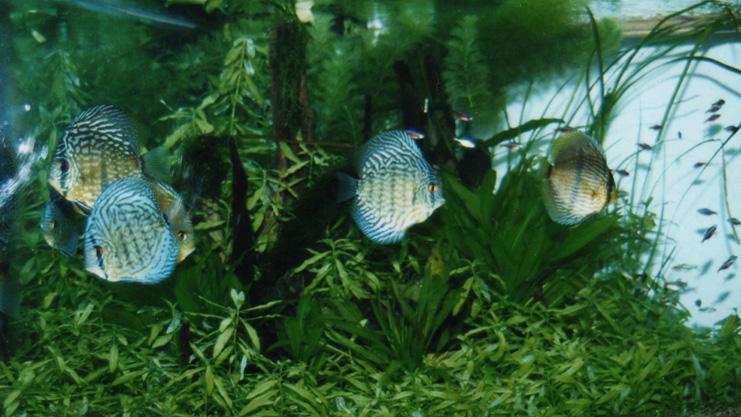When aquarium hobbyists think of a planted aquarium, they often think of a tank with tetras or livebearers. Cichlids are often overlooked as plant-safe fish because of their reputation for rearranging the tank. This article will showcase some great cichlids for your planted aquarium.
Some of the larger cichlids like discus (Symphysodon spp.), festivum (Mesonauta festivus and M. insignis), and angelfish (Pterophyllum. spp) are great centerpieces for the planted aquarium. They are primarily mid-water swimmers. Discus are often kept with tetras as small as cardinals (Paracheirodon axelrodi).

The discus does require higher temperatures of 82° to 86° F (28° to 30° C). My experience with plants at these higher temperatures is they thrive. Angelfish and festivum come from the same native waters of the Amazon as discus and do like to be kept at these higher temperatures.
Angelfish and festivum can be kept with tetras, but avoid smaller tetras like cardinals and neons (Paracheirodon innesi), as these small tetras often become prey for these adult fish.
Discus, angelfish, and festivum often spawn on broad-leaf plants like Amazon swords (Echinodorus spp.) and Anubias spp. The minimum aquarium size you should consider for these fish is 20 gallons (80 l). These fish do well in 5.0 to 7.8 pH, but soft acidic water is best for breeding.
South American "dwarf cichlids" (less than 4 inches or 10 cm) like Apistogramma spp., blue ram (Mikrogeophagus ramirezi), Nannacara sp., Bolivian ram (Mikrogeophagus altispinosa), Dwarf Flag Cichlid (Laetacara curviceps), Red-breasted Flag Cichlid (Laetacara dorsigera), checkerboard Cichlid (Dicrossus spp.) are all very good cichlids with plants.

Bottom row, left to right, Apistogramma cacatuoides, female Apistogramma pandurini, Bolivian Ram (Mikrogeophagus altispinosa), female blue ram (Mikrogeophagus ramirezi).
All South American dwarf cichlids stay near the bottom of the tank. Apistogrammas like to spawn in caves. I like to give them a ½ coconut shell with a hole drilled in the side. blue rams and Bolivian rams usually dig a shallow pit and lay their eggs at the bottom of the pit, but sometimes they will lay their eggs on driftwood or rock. Many Apistogramma species are harem spawners. One male will spawn with several females. The females will often take care of the eggs and fry on their own and chase the male away. These dwarf cichlids are generally safe with most tetras and only show aggression when defending a spawning site. These dwarf cichlids can be kept in a 10-gallon (40 l) aquarium. These fish also do well in 5.0 to 7.8 pH, but soft acidic water is best for breeding.

Left to right, female kribensis (Pelvicachromis pulcher), albino female kribensis, transvestitus (Nanochromis transvestitus), taeniatus (Pelvicachromis taeniatus).
These fish are cave spawners like South America's Apistogramma species and stay near the bottom of the tank. They do well with most tetras and are normally only aggressive around a spawning site. The kribensis is the most common of the West African dwarf cichlids and is available in an albino form. Some less common West African species will cost around $35 to $70 a pair. All of these fish will readily spawn in a planted aquarium. Some of these fish can tolerate very acidic water, as in the case of transvestitus; their natural water has been reported to be as low as 4.0 pH. These fish can also be kept at a higher pH, 7.0 to 7.8, without any problem. If kept in pairs, most West African dwarf cichlids can be kept in as small as a 10-gallon (40 l) aquarium, but I recommend a little larger to be on the safe side, as they tend to be a little more aggressive than their South American cousins.
How many dwarf cichlids you can add to an aquarium depends on the surface area. I recommend only one pair per square foot of surface area. So a standard US 20-gallon aquarium (24" x 12" x 16" or 60 x 30 x 40 cm) can, in most cases, hold two pairs of dwarf cichlids. Cichlids all have individual personalities, and what may work for you once may not work with different fish. Many cichlids of the same species can be peaceful, while a minority can be bullies. In most cases, dwarf cichlids will not cause harm to other fish in the aquarium.
These fish will do well on frozen brine shrimp, blood worms, and mysis shrimp. Live California blackworms are relished and are an excellent conditioning food for spawning. I have raised many dwarf cichlids on my own beef heart formula, and it is my preferred food for raising fish. I do not recommend dry flake or pellet foods as a staple, as these foods are generally low in digestible protein.
Hobbyists that already have a planted aquarium without cichlids are missing out on some fascinating behavior that makes cichlids popular with many aquarium hobbyists. All of these cichlids will leave other fish species in the aquarium alone. They will spar for territory. A planted community tank without cichlids is like a garden without a pond (just not complete).
